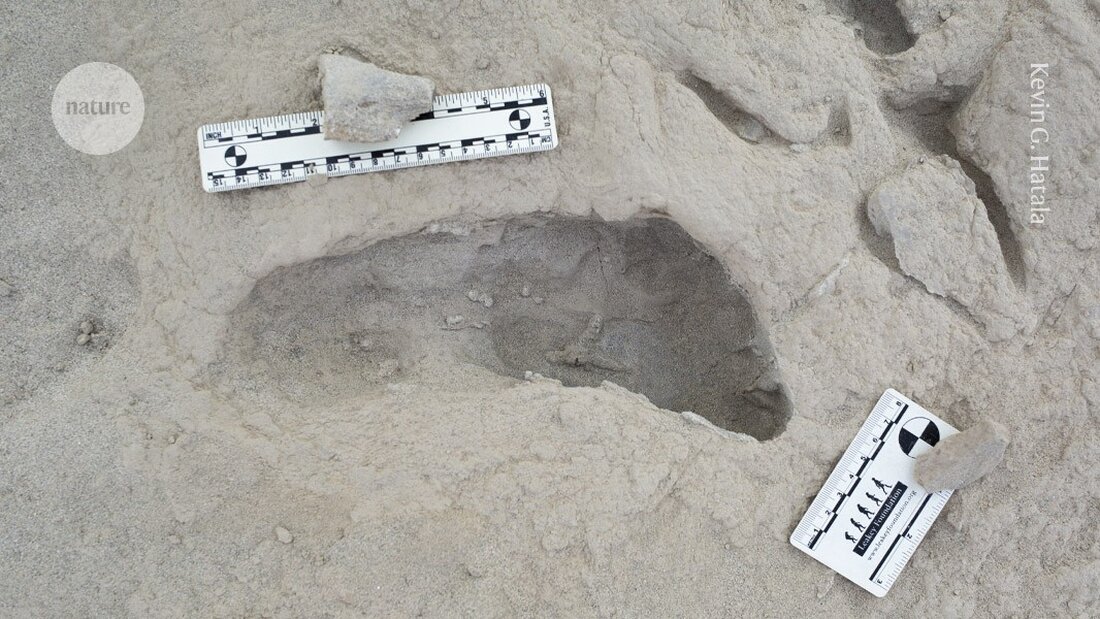Two ancient human relatives interbred 1.5 million years ago
1.5 million years ago, Homo erectus and Paranthropus boisei left their mark on the shores of a lake in Kenya.

Two ancient human relatives interbred 1.5 million years ago
About 1.5 million years ago, two ancient species crossed paths on a lakeshore in Kenya. Their footprints in the mud were frozen in time and remained undiscovered until 2021.
The analysis of the prints has shown that they are too Homo erectus, an ancestor of modern humans, and its more distant relative Paranthropus boisei. The two individuals crossed the lake area within a few hours or days, leaving the first direct evidence of different archaic hominin species living together in the same place.
“This is the first moment we have of these two species living in the same environment and possibly interacting with each other,” says Kevin Hatala, co-author of the study and a paleoanthropologist at Chatham University in Pittsburgh, Pennsylvania. The study was published November 28 in Science.
The casts preserved details about the individuals, including the height of their arches, the shape of their toes and their walking habits.
“It's really a moment in time,” says Tracy Kivell, a paleoanthropologist at the Max Planck Institute for Evolutionary Anthropology in Leipzig, Germany.
“These fossilized footprints are as close as we can get to a time machine that will take us back to the shore of an African lake 1.5 million years ago,” says Bernard Wood, a paleoanthropologist at George Washington University in Washington DC.
Hiking route
Previous studies, based primarily on finds, have suggested that different hominin species lived side by side. But Fossils are often spread over large areas and their estimated dates span thousands of years. “You don’t know whether they’re actually in contact with each other or not,” Kivell explains.
In July 2021, researchers discovered several sets of ancient footprints at the Koobi Fora site in the East Turkana area of Kenya, including a continuous path of prints left by one hominin individual, as well as isolated prints made by at least three others. The surface dates back to 1.52 million years and the impressions of rippled sand, reed beds and fish nests indicate that the area was a shallow water shore.
The path includes 13 footprints. Hatala and his team estimated that the hominin who left it walked at a speed of 1.81 meters per second, similar to a modern human running briskly.
Using 3D X-ray images, the researchers examined how the movement of a foot affects the marks left behind. They compared the depth of the arch of the foot and the angles of the toes in the hominin prints with those of humans. The analysis suggests that the isolated prints of individuals come from H. erectus, considered the first human species to walk upright and running like modern humans.
The researchers attributed the continuous path to an individual of the species Paranthropus boisei, which also appears to have appeared upright. This species had a flatter foot and the position of its big toe changed from step to step. The big toe had a greater range of motion—it could angle outward up to 19 degrees in the right foot and nearly 16 degrees in the left foot—compared to human big toes, which only angle outward to about 10 degrees. “There is a certain mobility in the big toe that goes beyond what we see in modern humans,” says Hatala.
Animal prints
The footprints of H. erectus and P. boisei are only a few meters apart. "We can only assume that they were aware of each other. How exactly they interacted, whether they learned from each other or whatever, remains a mystery," says Wood.
In addition to the hominin prints, the site also found preserved traces of 30 relatives of cattle, three horse-like animals and 61 birds, including a giant extinct stork, Leptoptilos falconeri.
Hatala hopes to combine data from footprints and bone fossils to "give a really high-resolution picture of what happened in this area during this phase of human evolution."
Wood says future studies could focus on the animals and birds. “This brings the whole thing to life in a way that is difficult to achieve with regular fossil finds.”
-
Hatala, K.G. et al. Science 386, 1004–1010 (2024).

 Suche
Suche
 Mein Konto
Mein Konto
